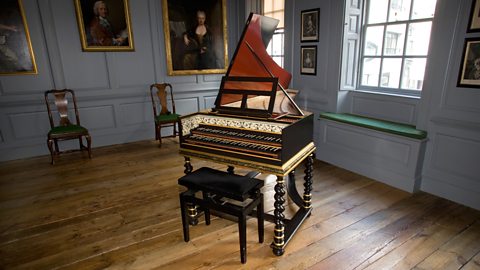Baroque

Baroque music comes from the period between approximately 1600 and 1750. Famous composers from this period include:
- Antonio Vivaldi
- George Frederic Handel
- Johann Sebastian Bach
Baroque music is recognised for its use of:
- repetition
- scales
- sequences
Melodies are played alongside each other to create polyphonicWith two or more melodies playing together music that contains contrapuntalPolyphonic music in which two or more melodies are played at the same time. The melodies have equal importance rather than one dominating. phrases. These phrases weave in and out of the music as melodies are passed around from player to player. The result sounds as if the instruments are imitating each other. This will sometimes happen through the complete piece, sometimes only for part of it.
Listen to this effect in J.S. Bach's 'Badinerie' from Suite No. 2.
'Badinerie' from Suite No. 2 by J.S. Bach
Instruments
Baroque composers used instruments available at the time:
- strings - violin, viola, cello and double bass
- woodwind - recorder or wooden flute, oboe, and bassoon
- brass - sometimes trumpet and/or horns
- percussion - timpani (kettledrums)
- key - harpsicord
Baroque instruments had very limited dynamicsHow loud or quiet a piece of music is contrast. Composers would ask their performers to play softly in the dynamic of piano and loudly in the dynamic of forte. There was very little dynamics in between.
The harpsichord made a short, staccato sound as the strings were plucked inside the instrument. If a Baroque composer wanted a longer sound on the harpsichord, he would have had to add ornaments such as trills and mordents.
A trill is when two notes are played alternatively in quick succession.
A mordent is a shorter ornament, with a note played, the note above played and then the first note played again in quick succession.
Ornaments like these were commonplace in Baroque music - they decorate the music while providing structure and style.
Types of baroque music
Religious singing was very popular in this period and many baroque composers wrote music for the church.
A common type of instrumental music found in this period is the concerto - a piece of music for a solo instrument accompanied by an orchestra.
Baroque concertos were called concerto gross - or great concertos - as the music would often be written for more than one solo instrument accompanied by an orchestra.
In this video, the Dunedin Consort performs the opening section of J.S. Bach’s Brandenburg Concerto No. 4 written in 1721. Musical director and harpsichord player John Butt introduces the piece, which is typical of the Baroque era (around 1600 to 1750).
The video features the following concepts - recorder, allegro, violin, arpeggio, sequence, harpsichord, viola, imitation, cello, solo, arco, ternary, change of key, ascending, descending.
Bach's Brandenburg Concerto
Listen to 'Prelude in C Major', also by Bach. This version is played on the piano. It is made up of a pattern of arpeggios and you will hear the music modulate until the composer brings us back to C major, finishing with a perfect cadence.
Prelude in C Major
'Dido's Lament' is an aria from the baroque opera Dido and Aeneas by Henry Parcel (1687). As you listen to the soprano voice singing listen out for the Baroque instruments including recorders and harpsichord. You will hear the cello play a ground bass, a repeated bass line which creates a sad mood for the whole song.
Dido's Lament performed by Sophie Bevan